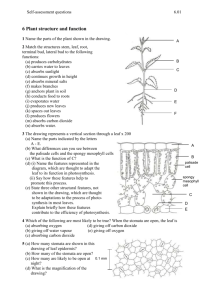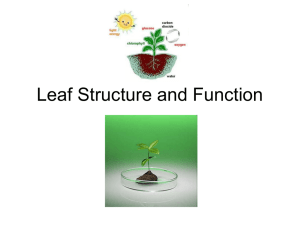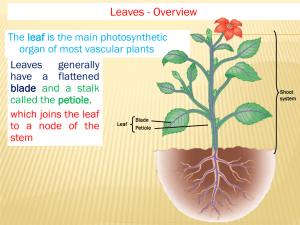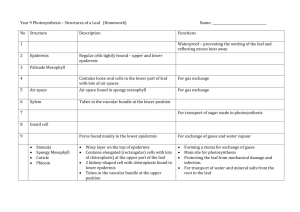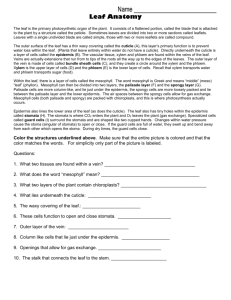LEAF ANATOMY LAB
advertisement
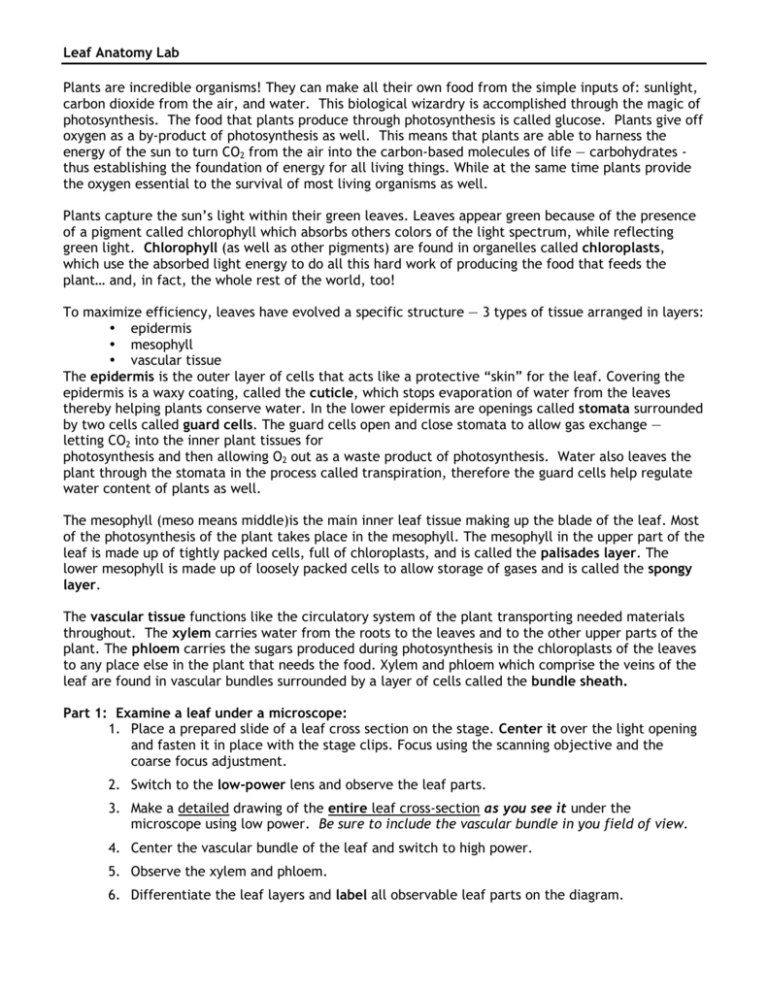
Leaf Anatomy Lab Plants are incredible organisms! They can make all their own food from the simple inputs of: sunlight, carbon dioxide from the air, and water. This biological wizardry is accomplished through the magic of photosynthesis. The food that plants produce through photosynthesis is called glucose. Plants give off oxygen as a by-product of photosynthesis as well. This means that plants are able to harness the energy of the sun to turn CO2 from the air into the carbon-based molecules of life — carbohydrates thus establishing the foundation of energy for all living things. While at the same time plants provide the oxygen essential to the survival of most living organisms as well. Plants capture the sun’s light within their green leaves. Leaves appear green because of the presence of a pigment called chlorophyll which absorbs others colors of the light spectrum, while reflecting green light. Chlorophyll (as well as other pigments) are found in organelles called chloroplasts, which use the absorbed light energy to do all this hard work of producing the food that feeds the plant… and, in fact, the whole rest of the world, too! To maximize efficiency, leaves have evolved a specific structure — 3 types of tissue arranged in layers: • epidermis • mesophyll • vascular tissue The epidermis is the outer layer of cells that acts like a protective “skin” for the leaf. Covering the epidermis is a waxy coating, called the cuticle, which stops evaporation of water from the leaves thereby helping plants conserve water. In the lower epidermis are openings called stomata surrounded by two cells called guard cells. The guard cells open and close stomata to allow gas exchange — letting CO2 into the inner plant tissues for photosynthesis and then allowing O2 out as a waste product of photosynthesis. Water also leaves the plant through the stomata in the process called transpiration, therefore the guard cells help regulate water content of plants as well. The mesophyll (meso means middle)is the main inner leaf tissue making up the blade of the leaf. Most of the photosynthesis of the plant takes place in the mesophyll. The mesophyll in the upper part of the leaf is made up of tightly packed cells, full of chloroplasts, and is called the palisades layer. The lower mesophyll is made up of loosely packed cells to allow storage of gases and is called the spongy layer. The vascular tissue functions like the circulatory system of the plant transporting needed materials throughout. The xylem carries water from the roots to the leaves and to the other upper parts of the plant. The phloem carries the sugars produced during photosynthesis in the chloroplasts of the leaves to any place else in the plant that needs the food. Xylem and phloem which comprise the veins of the leaf are found in vascular bundles surrounded by a layer of cells called the bundle sheath. Part 1: Examine a leaf under a microscope: 1. Place a prepared slide of a leaf cross section on the stage. Center it over the light opening and fasten it in place with the stage clips. Focus using the scanning objective and the coarse focus adjustment. 2. Switch to the low-power lens and observe the leaf parts. 3. Make a detailed drawing of the entire leaf cross-section as you see it under the microscope using low power. Be sure to include the vascular bundle in you field of view. 4. Center the vascular bundle of the leaf and switch to high power. 5. Observe the xylem and phloem. 6. Differentiate the leaf layers and label all observable leaf parts on the diagram. As mentioned previously, plants have special pores called stomata to allow passage of material. Unlike other plant epidermal cells, the guard cells contain chlorophyll to do photosynthesis. Guard cells expand when water is available, opening the stomata and allowing CO2 to enter the leaf. Guard cells contract when dehydrated, closing the stomata and thus keeping water in the plant from escaping. Most stomata are on the lower epidermis of the leaves. The number of stomata on the epidermal surface can tell you a lot about a plant. Usually, a high concentration of stomata indicates fast growth and wet climate. Lower concentrations of stomata indicate lower rates of photosynthesis and growth or adaptations for dry weather. Part 2: Observation of leaf Stomata 1. Choose a leaf from one of the plants. DO NOT REMOVE THE LEAF FROM THE PLANT!! 2. Paint a thick patch (at least one square centimeter) of clear nail polish on the underside of the leaf surface being studied. 3. Allow the nail polish to dry completely for several minutes. 4. Tape a piece of clear cellophane tape to the dried nail polish patch. 5. Gently peel the nail polish patch from the leaf by pulling on a corner of the tape and "peeling" the fingernail polish off the leaf. This is the leaf impression you will examine. 6. Tape your peeled impression to a very clean microscope slide. Use scissors to trim away any excess tape. Label the slide with plant name. 7. Examine the leaf impression under a light microscope at 400X. 8. Search for areas where there are numerous stomata, and where there is no dirt, thumb prints, damaged areas, or large leaf veins. Draw the leaf surface as it appears in your field of view. Then make a detailed drawing of ONE open stomate and one closed. 9. Count all the stomata in one microscopic field. Record the number on your data table. 10. Repeat counts for at least three other distinct microscopic fields. Record all the counts. Determine an average number per microscopic field. Leaf Anatomy Lab Name: Data & Analysis Period: Date: Part 1 Data: Make a detailed drawing of the entire leaf cross-section to scale as you see it under the microscope using low power. Label as many parts as you can identify. Part 2 Data: Leaf 1 Leaf 2 Leaf 3 Name of Leaf Stomata in field 1 Stomata in field 2 Stomata in field 3 Average Stomata OPEN Stomata CLOSED 1. Label the indicated parts of a leaf. 2. What is the main function of the leaf in a plant? 3. What does the term mesophyll refer to? 4. What types of cells are found in the mesophyll? 5. Why are the cells of the palisades layer packed so tightly together? 6. Why are the cells of the spongy layer packed so loosely together? 7. Where in the leaf are chloroplasts found? 8. Describe the function of chloroplasts. 9. Why would the cells of the palisades layer have more chloroplasts in them? 10. What are the functions of xylem and phloem respectively? 11. Write out the chemical equation for photosynthesis (Think about the reactants and products). 12. Describe how the functions of xylem and phloem relate specifically to the process of photosynthesis. 13. Which leaf had the most stomata? Why do you think this was so? 14. Define transpiration. 15. Why do stomates need to be open? 16. List the three gases move in and out of the leaf stomata and the direction of their movement. 17. Under what conditions would guard cells close the stomates? Explain why?



